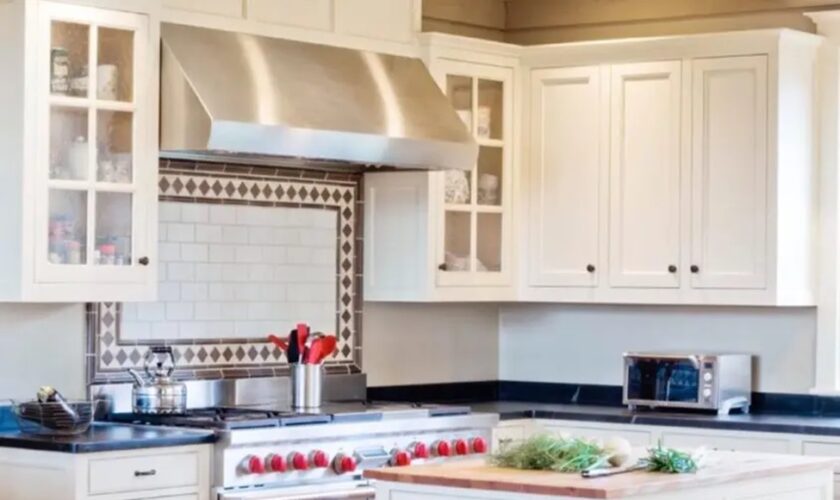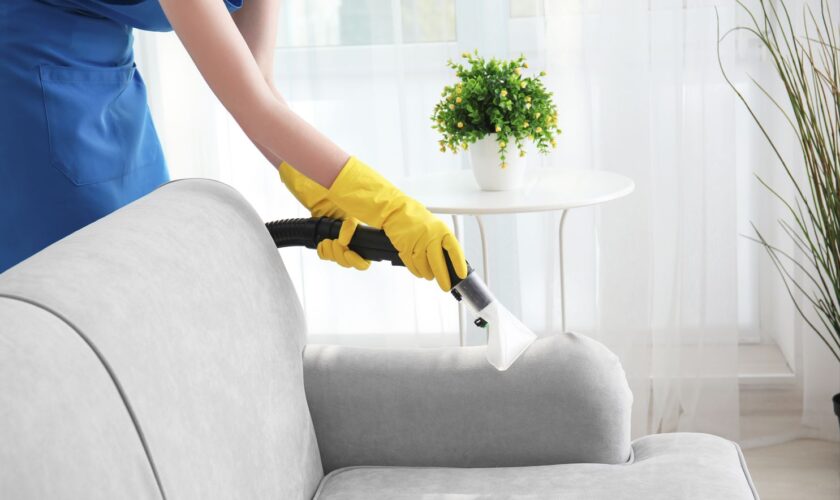There are five primary types of kitchen range hoods, each with its own unique design and functionality: wall mounted hoods, island hoods, range hood inserts, under cabinet hoods, and professional-grade hoods.
While all range hoods serve the essential purpose of removing smoke, grease, and other airborne contaminants generated during cooking and cleaning, the effectiveness of a range hood may vary.
This article explores various kitchen ventilation design styles and features of range hoods to assist you in determining the most suitable type for your kitchen needs.
Wall Mount Range Hoods
Wall-mounted range hoods are among the most prevalent types of stove hoods found in kitchens. These ventilation units are securely affixed to the kitchen wall. For optimal performance, it’s recommended to install your wall range hood approximately 28″-36” above the stove cooking surface, ensuring effective capture of cooking fumes and extending the lifespan of the hood.
Furthermore, wall-mounted range hoods come in various shapes. The pyramid chimney style or tapered hood is the most common type. Alternatively, some models feature a triangular design with flat sides.
When installed beneath cabinets, they are referred to as under cabinet range hoods and typically do not have anything mounted above them. Certain wall-mounted range hoods can also serve as under cabinet hoods, depending on the model. Be sure to consult with the range hood supplier to explore your options.
If you found these images of wall-mounted range hoods appealing, be sure to explore more customer kitchen examples showcasing them.
Island Range Hoods
Island range hoods serve as stunning focal points in kitchen spaces. Unlike wall-mounted range hoods, island hoods are not affixed to a wall. Due to their positioning and the increased air movement around kitchen islands, they require higher CFM (cubic feet per minute) ratings to effectively filter unwanted air from your kitchen.
Island range hoods are available in various shapes and styles. They are mounted to the ceiling, requiring ductwork to run through the ceiling as well. Some island hoods, like our 42″ Flush Island Pro, are designed to be flush with the ceiling.
It’s important to note that some homes may lack the necessary clearance or structural design to accommodate ductwork through the ceiling. Ensure that your home can accommodate the required ductwork from the hood to the exterior of your home.
In cases where ductwork installation is needed, a local contractor can typically perform the installation. However, this service may incur an additional cost, typically around $500.
Range Hood Inserts
Range hood inserts are specifically crafted to be integrated into custom hoods. Typically concealed within highly tailored cabinets positioned above the cooktop or stove, these inserts offer a seamless appearance.
They provide an excellent solution for those seeking complete control over the aesthetics of their ventilation fan or for individuals wishing to transform a pre-existing cabinet into a functional range hood.
Custom range hood inserts encompass a diverse array of designs, including copper, tile, marble, and intricately carved wood options. This type of hood allows homeowners to set the tone or theme of their kitchen, whether aiming for a rustic, traditional ambiance, a modern and minimalist aesthetic, or anything in between.
For those inclined towards DIY projects, numerous online resources, including tutorials on YouTube and Pinterest, offer guidance on constructing custom range hood covers. At Proline Range Hoods, we offer a stunning selection of highly customizable range hood inserts to cater to your unique cabinet requirements.
Under Cabinet Range Hoods
Under cabinet range hoods are an ideal choice for individuals with cabinets or storage space positioned above their cooktop. By opting for this type of hood, you can retain additional cabinet storage while enhancing your kitchen’s ventilation with a professional range hood, replacing the over-the-range (OTR) microwave.
Professional Grade Range Hoods
Proline stands out as one of the few companies offering a specialized range of hoods tailored for passionate cooks. Renowned for our commitment to excellence, our professional hoods represent the pinnacle of quality in the industry. Notably, celebrity chef Gordon Ramsay even entrusted one of our hoods to his head chef for personal use, a testament to our reputation for top-notch products. You can witness this endorsement on Houzz.
Our professional-grade range hoods are designed for discerning individuals who demand precision and efficiency in their kitchen appliances. Crafted to meet the highest standards, our professional series hoods deliver unrivaled performance. Equipped with a powerful fan and extensive control options, they excel in eliminating toxins and unpleasant odors from the kitchen environment.
Defined by a CFM (cubic feet per minute) rating of 900 or higher, our professional range hoods meet the stringent criteria for professional-grade ventilation.
Downdraft Range Hoods or Ventilation
Downdraft hoods are often considered less effective compared to other types of hoods for several reasons.
Firstly, cooking exhaust, such as smoke, naturally rises, making it more efficient to capture it where it naturally flows, upwards, rather than attempting to redirect it sideways or downwards.
Secondly, downdraft hoods typically have a maximum power output of around 1,000 CFM (cubic feet per minute), whereas island hoods can reach up to 2000 CFM. While not everyone requires such high power, having the capability allows island hoods to operate at lower, quieter settings most of the time, with the ability to quickly clear the room when necessary.
Thirdly, the capture area of a downdraft hood is significantly smaller compared to other hood types, resulting in an inability to effectively cover a cooktop and capture all steam, smoke, and chemicals generated during cooking, particularly noticeable for grilling or wok cooking enthusiasts.
If you have concerns about whether a downdraft hood can keep up with your cooking needs, it is likely that it may not suffice.
However, downdraft hoods can still serve as a sleek addition to your kitchen. Many models can be installed as pop-up vents, discreetly hiding from view when not in use. For this reason, some individuals opt for them, considering it better to have some ventilation than none at all.
Microwave Range Hoods
Similar considerations apply to kitchen ventilation integrated into microwave ovens. Microwave vent hoods are typically ductless, meaning they recirculate air back into the home rather than venting it outside.
As they do not vent externally, they are less effective compared to standalone range hoods. Nevertheless, they offer affordability and space-saving benefits in the kitchen.
For many of the same reasons that downdraft ventilation may not be optimal, microwave vent hoods present similar limitations.
Range Hood Venting Options
All range hoods can be categorized as either ducted, also known as vented, or ductless, also known as recirculating.
Ductless Range Hoods
A ductless range hood operates by cleaning the air around your cooktop area without venting it outside your home. Instead, it employs filters, typically charcoal, to purify the air. While effective to some extent, ductless hoods are generally not as efficient as ducted range hoods.
Ducted Range Hoods
Ducted range hoods work by directing air contaminants and grease outside the home through ductwork. This ductwork is typically installed either in the ceiling for island hoods or in the wall for other hood types. Professionals often recommend ducted range hoods for their superior effectiveness in maintaining clean air in the kitchen.
Additional Range Hood Features:
CFM
CFM, or cubic feet per minute, measures the airflow rate into or out of your cooking area. It’s a crucial metric for all kitchen ventilation systems. The appropriate CFM for your range hood depends on factors like your cooktop type (gas or electric).
LED Lights vs. Halogen Lights
Range hoods may come with either LED or halogen lights, both providing efficient illumination for cooking tasks. However, many prefer LED bulbs due to their longer lifespan, energy efficiency, and other benefits.
Auto Shut Off Timer
An auto shut off timer feature is convenient for those prone to forgetting to turn off their range hoods. Models with a built-in 15-minute auto-shutoff timer offer added peace of mind.
Baffle, Mesh, and Charcoal Filters
Baffle and mesh filters serve the same purpose of trapping grease and cooking debris, though they differ in material and ease of cleaning. Baffle filters, typically made of high-quality metals like stainless steel, are easier to clean compared to mesh filters. Charcoal filters, while not requiring cleaning, need replacement every three to six months.
Regular cleaning or replacement of filters is essential to ensure optimal hood efficiency.
These insights can aid in selecting the ideal range hood for your needs. Be sure to explore related articles for further guidance.


